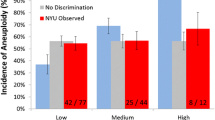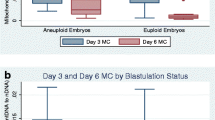Abstract
Purpose
This study aimed to test whether there is an association between embryo morphokinetic parameters and ploidy status.
Methods
Patients with high risk of aneuploidy were analyzed by time-lapse microscopy combined with preimplantation genetic screening (PGS). Accordingly, 256 blastocysts from 75 patients were subjected to trophectoderm biopsy and microarray comparative genomic hybridization (array-CGH). Blastocyst development process was analyzed using time-lapse images.
Results
Morphokinetic parameters: tPNf, t2, t3, t4, t5, t8, t9, tcom, tM, tSB, tB, tEB, CC1, CC2, CC3, S2, S3, t5-t2, and tB-tSB showed no significant difference in euploid embryos compared to aneuploid counterparts. In addition, two risk models based on previously published morphokinetic parameters failed to segregate euploid from aneuploid embryos.
Conclusions
Morphokinetic parameters subjected to investigation in the present study failed to improve the chance of selecting euploid embryos.


Similar content being viewed by others
References
Fragouli E, Wells D. Aneuploidy in the human blastocyst. Cytogenet Genome Res. 2011;133(2–4):149–59.
Angell RR, Aitken RJ, van Look PF, et al. Chromosome abnormalities in human embryos after in vitro fertilization. Nature. 1983;303(5915):336–8.
Brezina PR, Brezina DS, Kearns WG. Preimplantation genetic testing. BMJ. 2012;345:e5908.
Demko ZP, Simon AL, McCoy RC, et al. Effects of maternal age on euploidy rates in a large cohort of embryos analyzed with 24-chromosome single-nucleotide polymorphism-based preimplantation genetic screening. Fertil Steril. 2016;105(5):1307–13.
Scott RT Jr, Upham KM, Forman EJ, et al. Blastocyst biopsy with comprehensive chromosome screening and fresh embryo transfer significantly increases in vitro fertilization implantation and delivery rates: a randomized controlled trial. Fertil Steril. 2013;100(3):697–703.
Chang J, Boulet SL, Jeng G, et al. Outcomes of in vitro fertilization with preimplantation genetic diagnosis: an analysis of the United States Assisted Reproductive Technology Surveillance Data, 2011-2012. Fertil Steril. 2016;105(2):394–400.
Chung MK, Jeong HJ, Lee JH, et al. Comprehensive chromosome analysis of blastocysts before implantation using array CGH. Mol Cytogenet. 2013;6(1):22.
Hellani A, Abu-Amero K, Azouri J, et al. Successful pregnancies after application of array-comparative genomic hybridization in PGS-aneuploidy screening. Reprod BioMed Online. 2008;17(6):841–7.
Johnson DS, Gemelos G, Baner J, et al. Preclinical validation of a microarray method for full molecular karyotyping of blastomeres in a 24-h protocol. Hum Reprod. 2010;25(4):1066–75.
Treff NR, Tao X, Ferry KM, et al. Development and validation of an accurate quantitative real-time polymerase chain reaction-based assay for human blastocyst comprehensive chromosomal aneuploidy screening. Fertil Steril. 2012;97(4):819–24.
Tan Y, Yin X, Zhang S, et al. Clinical outcome of preimplantation genetic diagnosis and screening using next generation sequencing. Gigascience. 2014;3(1):30.
Bielanska M, Tan SL, Ao A. High rate of mixoploidy among human blastocysts cultured in vitro. Fertil Steril. 2002;78(6):1248–53.
Esfandiari N, Bunnell ME, Casper RF. Human embryo mosaicism: did we drop the ball on chromosomal testing? J Assist Reprod Genet. 2016;33(11):1439–44.
Kirkegaard K, Kesmodel US, Hindkjaer JJ, et al. Time-lapse parameters as predictors of blastocyst development and pregnancy outcome in embryos from good prognosis patients: a prospective cohort study. Hum Reprod. 2013;28(10):2643–51.
Meseguer M, Herrero J, Tejera A, et al. The use of morphokinetics as a predictor of embryo implantation. Hum Reprod. 2011;26(10):2658–71.
Desai N, Ploskonka S, Goodman LR, et al. Analysis of embryo morphokinetics, multinucleation and cleavage anomalies using continuous time-lapse monitoring in blastocyst transfer cycles. Reprod Biol Endocrinol. 2014;12:54.
Chawla M, Fakih M, Shunnar A, et al. Morphokinetic analysis of cleavage stage embryos and its relationship to aneuploidy in a retrospective time-lapse imaging study. J Assist Reprod Genet. 2015;32(1):69–75.
Basile N, Nogales Mdel C, Bronet F, et al. Increasing the probability of selecting chromosomally normal embryos by time-lapse morphokinetics analysis. Fertil Steril. 2014;101(3):699–704.
Campbell A, Fishel S, Bowman N, et al. Modelling a risk classification of aneuploidy in human embryos using non-invasive morphokinetics. Reprod BioMed Online. 2013;26(5):477–85.
Campbell A, Fishel S, Bowman N, et al. Retrospective analysis of outcomes after IVF using an aneuploidy risk model derived from time-lapse imaging without PGS. Reprod BioMed Online. 2013;27(2):140–6.
Rienzi L, Capalbo A, Stoppa M, et al. No evidence of association between blastocyst aneuploidy and morphokinetic assessment in a selected population of poor-prognosis patients: a longitudinal cohort study. Reprod BioMed Online. 2015;30(1):57–66.
Kramer YG, Kofinas JD, Melzer K, et al. Assessing morphokinetic parameters via time lapse microscopy (TLM) to predict euploidy: are aneuploidy risk classification models universal? J Assist Reprod Genet. 2014;31(9):1231–42.
Swain JE. Could time-lapse embryo imaging reduce the need for biopsy and PGS? J Assist Reprod Genet. 2013;30(8):1081–90.
Del Carmen Nogales M, Bronet F, Basile N, et al. Type of chromosome abnormality affects embryo morphology dynamics. Fertil Steril. 2017;107(1):229–35.
Minasi MG, Colasante A, Riccio T, et al. Correlation between aneuploidy, standard morphology evaluation and morphokinetic development in 1730 biopsied blastocysts: a consecutive case series study. Hum Reprod. 2016;31(10):2245–54.
Gardner DK, Lane M. Culture and selection of viable blastocysts: a feasible proposition for human IVF? Hum Reprod Update. 1997;3(4):367–82.
Ciray HN, Aksoy T, Goktas C, et al. Time-lapse evaluation of human embryo development in single versus sequential culture media—a sibling oocyte study. J Assist Reprod Genet. 2012;29(9):891–900.
Reed ML, Hamic A, Thompson DJ, et al. Continuous uninterrupted single medium culture without medium renewal versus sequential media culture: a sibling embryo study. Fertil Steril. 2009;92(5):1783–6.
Morbeck DE, Baumann NA, Oglesbee D. Composition of single-step media used for human embryo culture. Fertil Steril. 2017;107(4):1055–60.
Liu Y, Chapple V, Roberts P, et al. Prevalence, consequence, and significance of reverse cleavage by human embryos viewed with the use of the embryoscope time-lapse video system. Fertil Steril. 2014;102(5):1295–300.
Rubio I, Kuhlmann R, Agerholm I, et al. Limited implantation success of direct-cleaved human zygotes: a time-lapse study. Fertil Steril. 2012;98(6):1458–63.
Ambroggio J, Gindoff PR, Dayal MB, et al. Multinucleation of a sibling blastomere on day 2 suggests unsuitability for embryo transfer in IVF-preimplantation genetic screening cycles. Fertil Steril. 2011;96(4):856–9.
Kligman I, Benadiva C, Alikani M, et al. The presence of multinucleated blastomeres in human embryos is correlated with chromosomal abnormalities. Hum Reprod. 1996;11(7):1492–8.
Acknowledgement
This research was funded by National Research and Development Plan (2016YFC1000600) and Major Program of National Natural Science Foundation of China (8149073).
Author information
Authors and Affiliations
Corresponding author
Rights and permissions
About this article
Cite this article
Zhang, J., Tao, W., Liu, H. et al. Morphokinetic parameters from a time-lapse monitoring system cannot accurately predict the ploidy of embryos. J Assist Reprod Genet 34, 1173–1178 (2017). https://doi.org/10.1007/s10815-017-0965-8
Received:
Accepted:
Published:
Issue Date:
DOI: https://doi.org/10.1007/s10815-017-0965-8




